|
Trench and shovel probe excavations continued on Day 2 of the 2013 field season of the Ifugao Archaeological Project. This early, the team has already uncovered two trench units with rich cultural deposits. Trench 6 provided two large water jars which were left in the unit overnight, with plans to fully expose them today. Trench 7 had an almost intact small pot. Shovel probe units, on the other hand, provided valuable information on the extent of cultural deposits. Shovel probe unit 5 contained remains of possible infant burial. Field Diary 05/06/2013, Wednesday Site Report – Trench 6 By: Oliver Lim We returned to the Old Kiyyangan Village to resume excavations on trench 6. I was joined by my teammates Alea and Gera. We decided to continue the excavation of the trench’s agricultural layer in 10cm arbitrary levels. We did a quick plan sketch in the morning and re-measured the depth of the trench before starting excavations. The depth measured approximately 30cm and we were to bring it down to 40cm below the surface. We then split the trench up into quadrants and excavated in our individual quadrants. Within two minutes into excavation, we discovered a large pot sticking out of the middle of the trench on the northern end where Gera and I were excavating. After careful exposure, we realized that the pot was large both in diameter and height. As it was also breaking into pieces, we decided to level the ground in the trench to further expose the pot. We believe that the pot might have been discarded or ‘dropped’ on the site resulting in its shattering. Stephen believes that the pot was a water jug, used to hold a large amount of water. 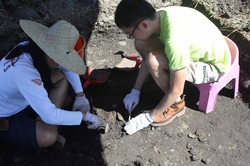 Gera Datuin and Ollie Lim. Gera Datuin and Ollie Lim. The further excavation of the agricultural layer produced the same earthenware pottery pieces we found on the first day. We were fortunate to dig up another porcelain bit. There was no visible change in stratigraphy although we found small sections of sand, a small section of charcoal and bioturbation in the North West quadrant. Next to the bioturbation, I discovered a more complete pot. As it was buried below the 40cm depth, we decided to excavate it tomorrow as we continue to level the ground, increasing the trench’s depth. Gera left the trench in the afternoon for trench 8 but we were fortunate enough to be joined by Jay. After a hard day’s excavation, we managed to only decrease the trench’s depth by a further 10cm due to the soil’s rocky and clayey disposition. The North East quadrant of the trench was especially difficult to dig. We cleaned up the trench and photographed it before trying to excavate the pot in the center. As the pot in the center of the pit was too large to excavate, we decided to leave it for tomorrow. We covered the two pots with plastic sheets before moving some soil over. Hopefully they will still be in place tomorrow for the excavation. 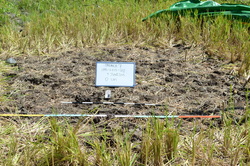 04 June 2013 Ifugao Archaeological Project Baguilat Property Site CAR-2012-W1 TRENCH 7 Daily Trench Report (Harpy Valerio): Trench 7 is located in the general area where locals mentioned possible burials. It is southwest of Trench 6 and west of trenches 1, 2 and 5 from the excavation season last year. It measures 2x2 meters and has a north-south orientation so as to make it easier to orient the possible burial/s. Trench 7 was opened with the specific objective of investigating the “ancestral burial site” and the possible burial/s in line with the general objective of this season: to investigate the 180 house-settlement in Kiyyangan, based on a Spanish account. Trench 7 was covered with rice stalks prior to excavation. Some were pulled out to be able to outline the square better. This was done with the agricultural activities in mind, hence a disturbed area that would not be able to answer or contribute to the archaeological research questions of the project, at present. After cleaning the vegetation Level 1, dark brown silty clay was exposed and excavated with a shovel until a change in compactness was observed, implying a new sediment layer. The shovel was used as it is known from the findings from last year’s excavation season and from observation that the 1st sediment layer is agricultural. Layer 1 ended with the following depths: NW corner = 13.0cm DBS; NE corner = 15.0cm DBS; SW corner = 15.3cm DBS; SE corner = 13.0cm DBS; Center = 16.0cm DBS. The measurements were taken from the SW ground surface. Earthenware sherds, a faunal long bone fragment and petrified wood fragments were excavated in Layer 1. The next layer was relatively looser than Layer 1. An earthenware fragment (Figure 3) was found in the NW quadrant in Layer 2 which was hypothesized to either be a base or lid fragment. It was not collected as possible associated earthenware was expected. A number of boulders were also found and it was initially thought to be a possible hearth. However, after exposing the rest of the boulders (Figure 4), the hearth hypothesis was trashed because the arrangement of said boulders did not resemble that of a typical hearth. It was decided to further expose the boulders and investigate whether it is a feature or not. The excavation, for the day, ended at ~30cm DBS. 05 June 2013 Ifugao Archaeological Project Baguilat Property Site CAR-2012-W1 TRENCH 7 Daily Trench Report (Harpy Valerio): The day commenced with the fulfillment of the non-excavation responsibilities of the trench and the observation that the pottery fragment from yesterday was missing. Layer 2 was then excavated to be brought down to 40cm below surface. During excavation an earthenware rim, seemingly intact, was exposed in the NW quadrant of Trench 7 (Figure 1 & 2). This exposed a possible small jar and recorded as feature 1. This led to the hypothesis that the looted artifact from yesterday may be the lid of said jar based on the depth and location it was found. Excavation of the jar was difficult because of the 10-20cm rocks surrounding it (Figure 3). The rocks with the jar were documented before taking out the former. This was done twice as there were still rocks below the ones taken out. 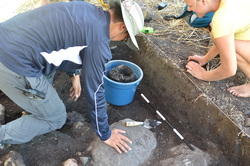 Extracted pot from Trench 7. Extracted pot from Trench 7. All the rocks were then taken out and excavation to 50cm DBS started as this was the lowest depth recorded when the rocks were taken out. Although the trench was not leveled to this depth by the end of the day this shall be one of the objectives for tomorrow. 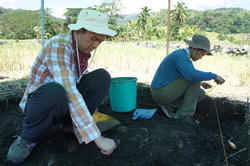 Jay Villapando and Charmaine Ledesma in Trench 8. Jay Villapando and Charmaine Ledesma in Trench 8. Trench 8 5 June 2013, Day 1 Daily report (Charmaine Ledesma) We started a new trench today. It is the 3rd trench opened this week. It is located southeast of trenches 3 and 4, which were found to be habitation sites. The purpose of this unit is to further examine the extent of the habitation area. If this unit yields enough information to suggest a domestic site, these stone walls then would most likely indicate house boundaries. Using shovels, we decided to excavate level 1 from 0 to 20cm below surface. There was a large concentration of boulders in the southern quadrants. In the cluster, one rock of interest was found in the northwest quadrant. Its distinct well-rounded shape and depression in the middle could suggest a possible grinding stone used for pounding materials. We found a good amount of ceramics, mostly earthenware sherds from various parts of a pottery (i.e. rim, neck, body). A large earthenware sherd complete with a rim and neck was found in the northeast quadrant. faunal remains possibly from deer and pigs were abundant in this level as well. A rough sketch was taken before we could decide to proceed further. We were able to reach 20cm by noon, and proceeded to the 2nd level (20-30cm below surface). The boulders that were within the level were taken out, except for the ones that were very large. This was done to keep control of our levels and maintain the 10cm interval. We also noted a change in the soil matrix in the northwest quadrant, when the clayey soil suddenly became incorporated with small pebbles. Level 2 continued to reveal large concentrations of ceramics and faunal remains. A large earthenware sherd was once again found in this level, only this time it was located in the southwest quadrant of our trench. We were unable to reach 30cm today, and so our goal tomorrow would be to complete level 2 and continue excavating the remaining agriculture layer to finally reach the cultural layer--the Old Kiyyangan Village.
1 Comment
|
Stephen AcabadoI am an anthropological archaeologist interested in human-environment interactions ArchivesCategories
All
|
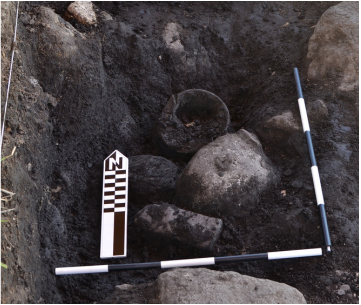
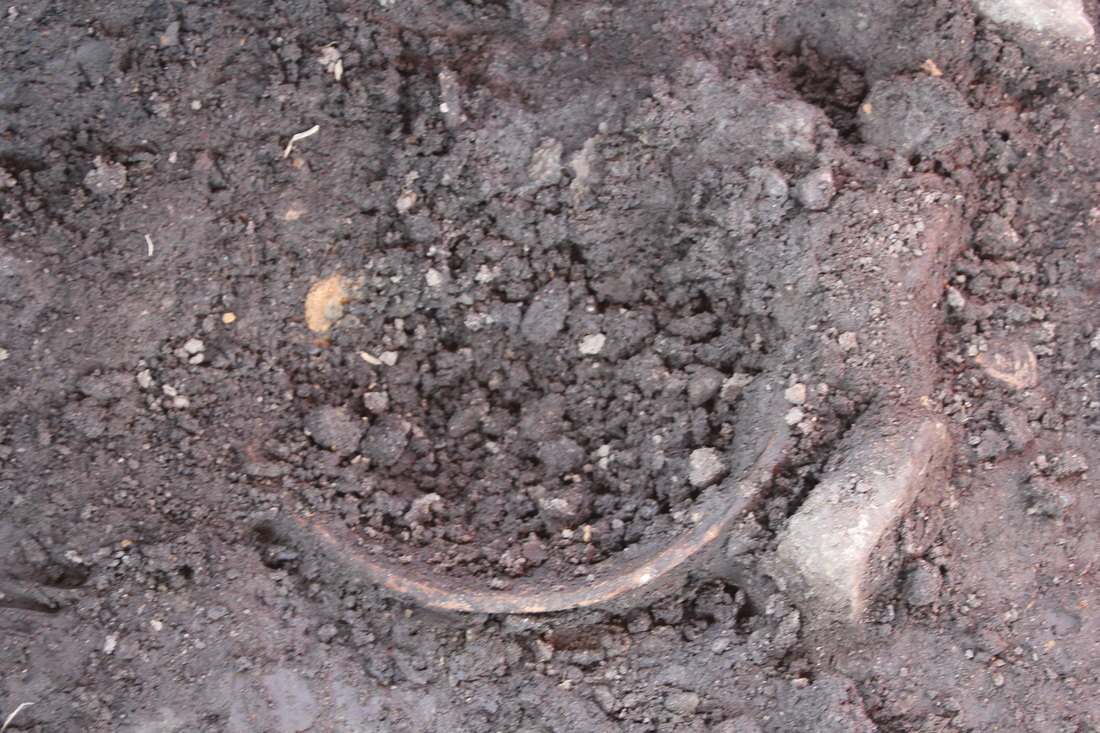
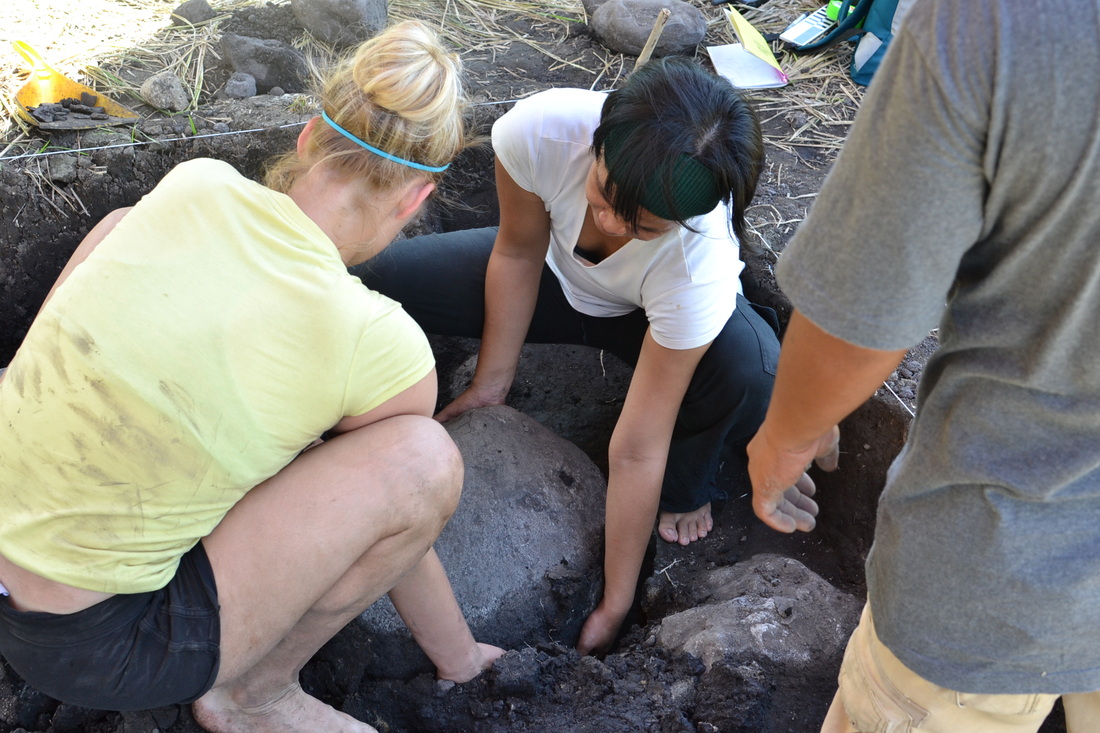
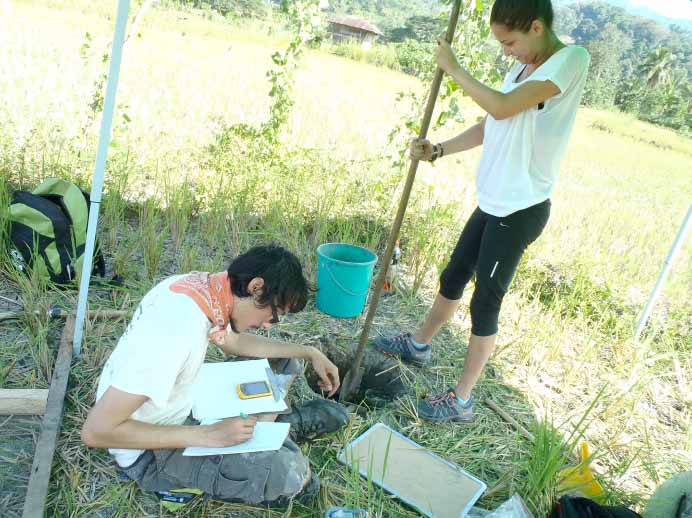
 RSS Feed
RSS Feed
